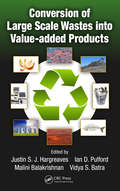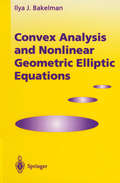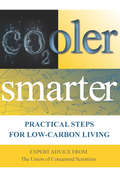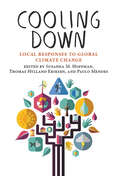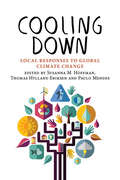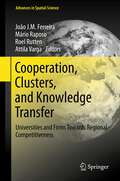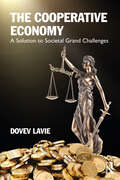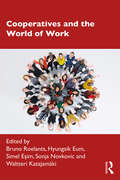- Table View
- List View
Conversations with Nature
by Peter Owen Jones‘I will carry this little book in my pocket... I will read the words on London buses and in Dartmoor woods. These across-species conversations are more than reverie, they are participation.’ – Martin Shaw, author of Smoke Hole and Courting the Wild Twin‘This is a book of profound imagination. Read it and you will know that we humans need to be humble and learn from the greatest teacher, Nature.’ – Satish Kumar, Editor Emeritus, Resurgence & Ecologist‘Once, we were one form among many in the garden. We learned to hear the voices of the mountains, the rivers, the sky, of silence. The mice spoke, the trees spoke, the stars spoke, the deer and the fox spoke, the snake spoke – and from these words we made being. These words formed great cities and their machines ever clamouring, and we let the silence slip and the words of the whispering world fall away beyond the mirror of our making.’ (From the Prologue.)These eighteen meditations, amplified by Jerry Shearing’s striking illustrations, offer luminous words enlivened with the weight of much listening. Through these ‘conversations’, Peter Owen Jones offers a pathway to reconnect with nature. Just a few sentences a day will provide sustenance for the soul.
Conversion of Large Scale Wastes into Value-added Products
by Justin S. J. Hargreaves Malini Balakrishnan Vidya S. Batra Ian D. PulfordConcern about the fate of waste products produced by a wide range of industrial processes has led to the realization that they may have potential uses and, therefore, value. In an effort to develop more sustainable processes and reduce waste storage, the use of waste as a resource has been gaining attention worldwide. Consequently, there have been
Convex Analysis and Nonlinear Geometric Elliptic Equations
by Ilya J. BakelmanInvestigations in modem nonlinear analysis rely on ideas, methods and prob lems from various fields of mathematics, mechanics, physics and other applied sciences. In the second half of the twentieth century many prominent, ex emplary problems in nonlinear analysis were subject to intensive study and examination. The united ideas and methods of differential geometry, topology, differential equations and functional analysis as well as other areas of research in mathematics were successfully applied towards the complete solution of com plex problems in nonlinear analysis. It is not possible to encompass in the scope of one book all concepts, ideas, methods and results related to nonlinear analysis. Therefore, we shall restrict ourselves in this monograph to nonlinear elliptic boundary value problems as well as global geometric problems. In order that we may examine these prob lems, we are provided with a fundamental vehicle: The theory of convex bodies and hypersurfaces. In this book we systematically present a series of centrally significant results obtained in the second half of the twentieth century up to the present time. Particular attention is given to profound interconnections between various divisions in nonlinear analysis. The theory of convex functions and bodies plays a crucial role because the ellipticity of differential equations is closely connected with the local and global convexity properties of their solutions. Therefore it is necessary to have a sufficiently large amount of material devoted to the theory of convex bodies and functions and their connections with partial differential equations.
Convexity Methods in Hamiltonian Mechanics (Ergebnisse der Mathematik und ihrer Grenzgebiete. 3. Folge / A Series of Modern Surveys in Mathematics #19)
by Ivar EkelandIn the case of completely integrable systems, periodic solutions are found by inspection. For nonintegrable systems, such as the three-body problem in celestial mechanics, they are found by perturbation theory: there is a small parameter € in the problem, the mass of the perturbing body for instance, and for € = 0 the system becomes completely integrable. One then tries to show that its periodic solutions will subsist for € -# 0 small enough. Poincare also introduced global methods, relying on the topological properties of the flow, and the fact that it preserves the 2-form L~=l dPi 1\ dqi' The most celebrated result he obtained in this direction is his last geometric theorem, which states that an area-preserving map of the annulus which rotates the inner circle and the outer circle in opposite directions must have two fixed points. And now another ancient theme appear: the least action principle. It states that the periodic solutions of a Hamiltonian system are extremals of a suitable integral over closed curves. In other words, the problem is variational. This fact was known to Fermat, and Maupertuis put it in the Hamiltonian formalism. In spite of its great aesthetic appeal, the least action principle has had little impact in Hamiltonian mechanics. There is, of course, one exception, Emmy Noether's theorem, which relates integrals ofthe motion to symmetries of the equations. But until recently, no periodic solution had ever been found by variational methods.
Convolutions in French Mathematics, 1800–1840: From the Calculus and Mechanics to Mathematical Analysis and Mathematical Physics (Science Networks. Historical Studies #4)
by Ivor Grattan-GuinnessCool Cities: Urban Sovereignty and the Fix for Global Warming
by Benjamin R. BarberA pointed argument that cities—not nation-states—can and must take the lead in fighting climate change Climate change is the most urgent challenge we face in an interdependent world where independent nations have grown increasingly unable to cooperate effectively on sustainability. In this book, renowned political theorist Benjamin R. Barber describes how cities, by assuming important aspects of sovereignty, can take the lead from faltering nation states in fighting climate change. Barber argues that with more than half the world's population now in urban areas, where 80 percent of both GDP and greenhouse gas emissions are generated, cities are the key to the future of democracy and sustainability. In this compelling sequel to If Mayors Ruled the World, Barber assesses both broad principles of urban rights and specific strategies of sustainability such as fracking bans, walkable cities, above-ground mining of precious resources, energy and heating drawn from garbage incineration, downtown wind turbines, and skyscrapers built from wood. He shows how cities working together on climate change, despite their differences in wealth, development, and culture, can find common measures by which to evaluate the radically different policies they pursue. This is a book for a world in which bold cities are collaborating to combat climate change and inspire hope for democracy even as reactionary populists take over national governments in the United States and Europe. It calls for a new social contract among citizens and municipalities to secure not only their sustainability but their survival.
Cool Places: Geographies of Youth Cultures
by Tracey Skelton Gill ValentineCool Places explores the contrasting experiences of contemporary youth. The chapters draw on techno music and ecstasy in Germany, clubbing in London, global backpacking and gangs in Santa Cruz as well as expereinces at home, on the streets and seeking employment. The contributors use these examples to explore representation and resistance and geographical concepts of scale and place in young people's lives within social, cultural and feminist studies to focus upon the complexities of youth cultures and their spatial representations and interactions. Contributors: Shane Blackman, Sophie Bowlby, Myrna Margulies Breitbart, Deborah Chambers, Luke Deforges, Claire Dwyer, Keith Hetherington, Cindi Katz, Heinz-Herman Kruger, Marion Leonard, Sally Lloyd Evans, Tim Lucas, Sara McNamee,Ben Malbon, Doreen Massey, Robina Mohammad, David Oswell, David Parker, Birgit Richard, Susan Ruddick, Tracey Skelton, Fiona Smith, Kevin Stevenson, Gill Valentine and Paul Watt
Cool Places: Geographies of Youth Cultures
by Tracey Skelton Gill ValentineCool Places explores the contrasting experiences of contemporary youth. The chapters draw on techno music and ecstasy in Germany, clubbing in London, global backpacking and gangs in Santa Cruz as well as expereinces at home, on the streets and seeking employment. The contributors use these examples to explore representation and resistance and geographical concepts of scale and place in young people's lives within social, cultural and feminist studies to focus upon the complexities of youth cultures and their spatial representations and interactions. Contributors: Shane Blackman, Sophie Bowlby, Myrna Margulies Breitbart, Deborah Chambers, Luke Deforges, Claire Dwyer, Keith Hetherington, Cindi Katz, Heinz-Herman Kruger, Marion Leonard, Sally Lloyd Evans, Tim Lucas, Sara McNamee,Ben Malbon, Doreen Massey, Robina Mohammad, David Oswell, David Parker, Birgit Richard, Susan Ruddick, Tracey Skelton, Fiona Smith, Kevin Stevenson, Gill Valentine and Paul Watt
Cooler Smarter: Practical Steps for Low-Carbon Living
by The Union of Concerned ScientistsHow can each of us live Cooler Smarter? While the routine decisions that shape our days-what to have for dinner, where to shop, how to get to work-may seem small, collectively they have a big effect on global warming.Based on an in-depth, two-year study by experts at The Union of Concerned Scientists, Cooler Smarter shows you how to cut your own global warming emissions by twenty percent or more. It offers science-based strategies to cut carbon, including chapters on transportation, home energy use, diet, personal consumption, as well as how best to influence your workplace, your community, and elected officials.The advice in Cooler Smarter can help save you money and live healthier. But its central purpose is to empower you, through low carbon-living, to confront one of society's greatest threats.
Cooling Down: Local Responses to Global Climate Change
by Susanna Hoffman Thomas Hylland Eriksen Paulo MendesClimate change is a slowly advancing crisis sweeping over the planet and affecting different habitats in strikingly diverse ways. While nations have signed treaties and implemented policies, most actual climate change assessments, adaptations, and countermeasures take place at the local level. People are responding by adjusting their practices, livelihoods, and cultures, protesting and migrating. This book portrays the diversity of explanations and remedies as expressed at the community level and its emphasis on the crucial importance of ethnographic detail in demonstrating how people in different parts of the world are scaling down the phenomenon of global warming.
Cooling Down: Local Responses to Global Climate Change
by Susanna M. Hoff man, Thomas Hylland Eriksen Paulo MendesClimate change is a slowly advancing crisis sweeping over the planet and affecting different habitats in strikingly diverse ways. While nations have signed treaties and implemented policies, most actual climate change assessments, adaptations, and countermeasures take place at the local level. People are responding by adjusting their practices, livelihoods, and cultures, protesting and migrating. This book portrays the diversity of explanations and remedies as expressed at the community level and its emphasis on the crucial importance of ethnographic detail in demonstrating how people in different parts of the world are scaling down the phenomenon of global warming.
Cooperation, Clusters, and Knowledge Transfer: Universities and Firms Towards Regional Competitiveness (Advances in Spatial Science)
by João J. M. Ferreira, Mário Raposo, Roel Rutten and Attila VargaCooperation and clusters have become the guiding paradigms for explaining and promoting regional competitiveness, but the cooperation process between firms and universities and the transfer of knowledge in guiding and nurturing regional competitiveness has received relatively little attention. This book strives to fill this gap in highlighting the connection between inter-firm cooperation in regional clusters, innovation and regional networks, and the role of universities in them . It goes beyond the traditional economic approach of clusters and includes ‘soft factors’ in the explanation of regional competitiveness, and connects the literature on clusters to the literature of learning and knowledge creation as sources of regional competitiveness. It aims to foster an international and interdisciplinary exchange of perspectives by presenting current developments, case studies, best practices as well as new integrated theoretical approaches and applications.
Cooperative Dynamics in Complex Physical Systems: Proceedings of the Second Yukawa International Symposium, Kyoto, Japan, August 24–27, 1988 (Springer Series in Synergetics #43)
by Hajime TakayamaMany novel cooperative phenomena found in a variety of systems studied by scientists can be treated using the uniting principles of synergetics. Examples are frustrated and random systems, polymers, spin glasses, neural networks, chemical and biological systems, and fluids. In this book attention is focused on two main problems. First, how local, topological constraints (frustrations) can cause macroscopic cooperative behavior: related ideas initially developed for spin glasses are shown to play key roles also for optimization and the modeling of neural networks. Second, the dynamical constraints that arise from the nonlinear dynamics of the systems: the discussion covers turbulence in fluids, pattern formation, and conventional 1/f noise. The volume will be of interest to anyone wishing to understand the current development of work on complex systems, which is presently one of the most challenging subjects in statistical and condensed matter physics.
The Cooperative Economy: A Solution to Societal Grand Challenges
by Dovev LavieSocietal grand challenges have taken a toll on humanity, which finds itself at a crossroads. The concentration of wealth and economic inequality, the dominance of Big Tech firms, the loss of privacy and free choice, and the overconsumption and abuse of natural resources have been reinforced by globalization. Regulation, legislation, international treaties, and government and corporate policies have fallen short of offering sufficient remedies. This book identifies the root cause of these problems and offers a bold solution: a new economic system, free from the design flaws that have contributed to these societal grand challenges. The proposed cooperative economy is an ethical community-driven exchange system that relies on collective action to promote societal values while accounting for resource constraints. Unlike the modern economic system that is predominantly driven by opportunistic behavior, the cooperative economy moves away from a materialistic orientation and follows a more balanced perspective that leverages prosocial behavior. The book explains how this new system adopts design principles that promote self-sufficiency of communities, sustainability and entrepreneurship while limiting overconsumption and excessive profit-making. It enhances economic equality by leveraging price subsidization and by restricting salary differences. The book describes how the system serves the interests of consumers, vendors, and employees while preventing the accumulation of power by the platform owner who operates this system. This book is invaluable reading for policymakers who have been searching for solutions to some of the grand challenges that our society faces, and to managers who have sought alternative ways to cope with platform ecosystems, resource shortages, and supply chain disruptions. It revisits long-held assumptions, offering a treatise and food for thought, as well as a plan for concrete action. The book is also highly relevant to scholars and students in the study of economics, strategy, innovation, and public policy and to all readers who are concerned about the future of our planet and society.
The Cooperative Economy: A Solution to Societal Grand Challenges
by Dovev LavieSocietal grand challenges have taken a toll on humanity, which finds itself at a crossroads. The concentration of wealth and economic inequality, the dominance of Big Tech firms, the loss of privacy and free choice, and the overconsumption and abuse of natural resources have been reinforced by globalization. Regulation, legislation, international treaties, and government and corporate policies have fallen short of offering sufficient remedies. This book identifies the root cause of these problems and offers a bold solution: a new economic system, free from the design flaws that have contributed to these societal grand challenges. The proposed cooperative economy is an ethical community-driven exchange system that relies on collective action to promote societal values while accounting for resource constraints. Unlike the modern economic system that is predominantly driven by opportunistic behavior, the cooperative economy moves away from a materialistic orientation and follows a more balanced perspective that leverages prosocial behavior. The book explains how this new system adopts design principles that promote self-sufficiency of communities, sustainability and entrepreneurship while limiting overconsumption and excessive profit-making. It enhances economic equality by leveraging price subsidization and by restricting salary differences. The book describes how the system serves the interests of consumers, vendors, and employees while preventing the accumulation of power by the platform owner who operates this system. This book is invaluable reading for policymakers who have been searching for solutions to some of the grand challenges that our society faces, and to managers who have sought alternative ways to cope with platform ecosystems, resource shortages, and supply chain disruptions. It revisits long-held assumptions, offering a treatise and food for thought, as well as a plan for concrete action. The book is also highly relevant to scholars and students in the study of economics, strategy, innovation, and public policy and to all readers who are concerned about the future of our planet and society.
Cooperative Phenomena
by H. Haken M. WagnerThe study of cooperative phenomena is one of the dominant features of contem porary physics. Outside physics it has grown to a huge field of interdisciplinary investigation, involving all the natural sciences from physics via biology to socio logy. Yet, during the first few decades following the advent of quantum theory, the pursuit of the single particle or the single atom, as the case may be, has been so fascinating that only a small number of physicists have stressed the importance of collective behaviour. One outstanding personality among these few is Professor HERBERT FROHLICH. He has made an enormous contribution to the modern concept of cooperativity and has stimulated a whole generation of physicists. Therefore, it seemed to the editors very appropriate to dedicate a volume on "cooperative phenomena" to him on the occasion of his official retirement from his university duties. Nevertheless, in the course of carrying out this project, the editors have been somewhat amazed to find that they have covered the essentials of contemporary physics and its im pact on other scientific disciplines. It thus becomes clear how much HERBERT FROHLICH has inspired research workers and has acted as a stimulating discussion partner for others. FROHLICH is one of those exceptional scientists who have wor ked in quite different fields and given them an enormous impetus. Unfortunately, the number of scientists of such distinctive personality has been decreasing in our century.
Cooperatives and the World of Work
by Bruno Roelants Hyungsik Eum Simel Esim Sonja Novkovic Waltteri KatajamäkiAs the world of work and jobs is more uncertain than ever because of various trends impacting it, including the rise of robotics and the gig economy, Cooperatives and the World of Work furthers the debate on the future of work, sustainable development, and the social and solidarity economy of which cooperatives are a fundamental component. Throughout the book, the authors, who are experts in their respective fields, do not limit themselves to praising the advantages of the cooperative model. Rather, they challenge the narrow understanding of cooperatives as a mere business model and raise debate on the more fundamental role that cooperatives play in responding to social changes and in changing society itself. The book is unique in tracing the historical connection between cooperatives and the world of work since the end of the First World War and the recent shifts and restructuring in enterprise and the workplace. It presents a redefinition of the very concept of work, focusing on organizational innovation. This book is published in recognition of 100 years of the International Labour Organization, and gathers together research from leading experts who were brought together at an event co-hosted by the International Co-operative Alliance (ICA) and the International Labour Organization (ILO).
Cooperatives and the World of Work
by Bruno Roelants Hyungsik Eum Simel Esim Sonja Novkovic Waltteri KatajamäkiAs the world of work and jobs is more uncertain than ever because of various trends impacting it, including the rise of robotics and the gig economy, Cooperatives and the World of Work furthers the debate on the future of work, sustainable development, and the social and solidarity economy of which cooperatives are a fundamental component. Throughout the book, the authors, who are experts in their respective fields, do not limit themselves to praising the advantages of the cooperative model. Rather, they challenge the narrow understanding of cooperatives as a mere business model and raise debate on the more fundamental role that cooperatives play in responding to social changes and in changing society itself. The book is unique in tracing the historical connection between cooperatives and the world of work since the end of the First World War and the recent shifts and restructuring in enterprise and the workplace. It presents a redefinition of the very concept of work, focusing on organizational innovation. This book is published in recognition of 100 years of the International Labour Organization, and gathers together research from leading experts who were brought together at an event co-hosted by the International Co-operative Alliance (ICA) and the International Labour Organization (ILO).
Cooperatives in an Uncertain World: Perspectives from Switzerland and Its Neighbors (Contributions to Management Science)
by Stefano Brusoni Martin Gutmann Michael Ambühl Anja NiedworokThis book focuses on different aspects of cooperatives in Switzerland and its neighboring countries, and their contribution to meeting overarching societal challenges. It seeks to identify how cooperatives can tackle grand societal challenges and extends the body of research on cooperatives. The discussions are highlighted in the context of the UN’s Sustainable Development Goals. The respective chapters cover topics such as cooperatives in Switzerland (historical roots, current landscape, embeddedness in profit/nonprofit organizations, participatory governance and legal aspects), grand societal challenges and cooperatives, and the future with and of cooperatives. This is an open access book.
Coordinate Systems of the World: Datums and Grids
by Clifford J. MugnierA comprehensive consolidation of data for the world, this book gives a short precis of each nation, each nation’s history, its topography and a chronology of the development of geodetic surveying and coordinate systems for that specific nation. This book is a starting point of information for understanding the world’s datums and grids. Based on the details available for each nation, the reader is given an overall view that can answer questions regarding the sources of spatial information available, their limitations, and the critical things to be aware. The topographic maps compiled over the centuries represent the mixes of technology specifically to that nation. The book provides information and clues regarding existing maps and how those maps and coordinate systems were created.
Coordinate Systems of the World: Datums and Grids
by Clifford J. MugnierA comprehensive consolidation of data for the world, this book gives a short precis of each nation, each nation’s history, its topography and a chronology of the development of geodetic surveying and coordinate systems for that specific nation. This book is a starting point of information for understanding the world’s datums and grids. Based on the details available for each nation, the reader is given an overall view that can answer questions regarding the sources of spatial information available, their limitations, and the critical things to be aware. The topographic maps compiled over the centuries represent the mixes of technology specifically to that nation. The book provides information and clues regarding existing maps and how those maps and coordinate systems were created.
Coordination: Neural, Behavioral and Social Dynamics (Understanding Complex Systems)
by Armin Fuchs Viktor K. JirsaOne of the most striking features of Coordination Dynamics is its interdisciplinary character. The problems we are trying to solve in this field range from behavioral phenomena of interlimb coordination and coordination between stimuli and movements (perception-action tasks) through neural activation patterns that can be observed during these tasks to clinical applications and social behavior. It is not surprising that close collaboration among scientists from different fields as psychology, kinesiology, neurology and even physics are imperative to deal with the enormous difficulties we are facing when we try to understand a system as complex as the human brain. The chapters in this volume are not simply write-ups of the lectures given by the experts at the meeting but are written in a way that they give sufficient introductory information to be comprehensible and useful for all interested scientists and students.
Coordination Principle of Minerals Flotation
by Jianhua ChenThe advent of flotation, with selective interaction of reagents with minerals at its core, has greatly advanced the development of modern mining. Ever since, there has been continuous researched into the mechanism of mineral-reagent interactions, in an effort to design and develop more effective reagents. A unique perspective from coordination is presented to illustrate the principles of reagent molecules interacting with metal ions on mineral surface. For the first time, the influence is unveiled of mineral crystal structures and surrounding atoms on metal ion properties and further on mineral-reagent interactions. The introduction of classical theories for modern chemistry, including orbital structure, electron spin and orbital symmetry matching, into flotation is realized. Researchers, engineers and graduate students among others in the field of mineral processing may gain new insight into flotation and the development of novel reagents.
Copahue Volcano (Active Volcanoes of the World)
by Franco Tassi Orlando Vaselli Alberto Tomas CaselliThis book provides a comprehensive description of the volcanological, petrological and geochemical features of the Copahue volcano, located at the border between Argentina and Chile. Scientific studies are limited for this volcanic system, due to its remote location and difficult access in winter. However, Copahue is one of the most active volcanic systems in the southern Andes. Monitoring the volcano's activity is of utter importance, as it provides means of existence for the nearby village of the same name, hosting the world's highest-located hot-springs resort. This book's aim is to present the current monitoring activities, and to describe future research programs that are planned in order to mitigate volcanic hazards. Special attention is therefore devoted to the social and industrial activities close to the volcano, such as health therapies and geothermal energy exploitation. In a special section, the Copahue volcano is presented as a terrestrial modern analog for early-Earth and Mars environments.

